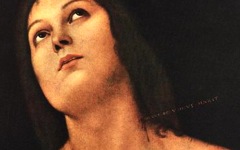Perugino’s Madonna and Child (n.d.) and Mary Magdalene (1500)
A well-known Madonna and Child in the Galleria Borghese in Rome is obviously by Perugino on account of the faces. He continuously drew the same facial type: round faces with arched eyebrows, a button nose, an almost invisible upper lip and a divided chin. Why did Perugino rely on that one face when he, like other contemporary artists, put so much effort into making his figures appear real in an illusionistic space?
Click next thumbnail to continue

Left: Detail of Madonna from Perugino's Madonna and Child, rotated.
Right: Detail of Perugino's Self-portrait
Click image to enlarge.
No-one seems to have noted, though, that Perugino's faces resemble his own self-portrait (right), even down to his most unusual chin, more at home on TV's Family Guy than the Lord's mother. Besides, I have shown in separate entries how many of his colleagues identified with the Virgin Mary and Christ too.1
Click next thumbnail to continue

Left: Detail of Christ from Perugino's Madonna and Child, rotated.
Right: Detail of Perugino's Self-portrait
Click image to enlarge.
That is why Perugino's infant Christ shares Perugino's arching eyebrows, button nose and thin upper lip. The wisp of blond hair on the forehead links them further. Those unaware, however, of the Inner Tradition might easily dismiss these facial similarities as a stylish conceit, a useful defense as well against charges of heresy from the outward-looking, literal-reading authorities in the Secular Church.
Click next thumbnail to continue
The desire to unify with God is not heresy but a foundational idea of Christianity, then long forgotten by the Secular Church but kept alive in the monastic establishments of the Regular Church, in mystical groups independent of any Church and within individual minds like those of painters, sculptors, composers and poets. Perugino's "portrait" of Mary Magdalene (left) was painted the same year as Dürer's Self-portrait as Christ (1500), a painting that has long mystified academics but which is of similar purpose: to demonstrate to those who can see that the true path to Wisdom and God is internal.
Click next thumbnail to continue

Left: Detail of from Perugino's Mary Magdalene, rotated.
Right: Detail of Perugino's Self-portrait
Click image to enlarge.
Perugino identified with all the figures in his paintings as he showed by giving them all his own facial features. Yet not only did he identify with human beings but with animals too, as I have shown in a separate entry,2
More Works by Perugino
In this early painting of St. Sebastian by Perugino the artist signed his name as though it was the arrow: "Opus Peruginus Pinxit."

Perugino’s Bust of St. Sebastian (1493)
Notes:
1. See entries by Simon Abrahams on Mantegna, Leonardo, Michelangelo, Raphael and Titian.
2. See entry by Abrahams titled: Perugino and Stubbs as Lions.
Original Publication Date on EPPH: 14 Jul 2012. | Updated: 0. © Simon Abrahams. Articles on this site are the copyright of Simon Abrahams. To use copyrighted material in print or other media for purposes beyond 'fair use', you must obtain permission from the copyright owner. Websites may link to this page without permission (please do) but may not reproduce the material on their own site without crediting Simon Abrahams and EPPH.




